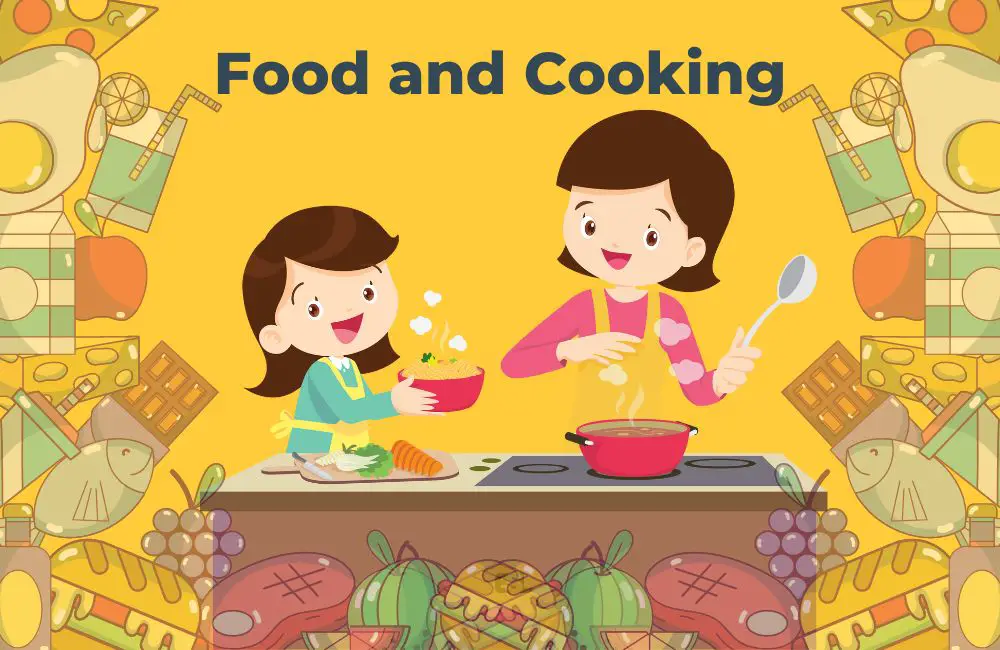The world of food and cooking is a sensory adventure filled with tantalizing tastes, stunning visuals, and fragrant smells. To fully explore this world, you need more than just your five senses – you need the language of food. The right vocabulary will allow you to describe flavors with nuance, follow recipes with precision, and express your culinary preferences with clarity.
Whether you’re a seasoned home cook or a food enthusiast, this comprehensive food and cooking vocabulary guide will elevate your culinary literacy to new heights.
If you are searching for an effective English language vocabulary builder, try Word Power Made Easy: The Complete Handbook for Building a Superior Vocabulary (Amazon Link). This time-tested classic has helped millions achieve mastery of English and improve their communication skills in business, the classroom, and in life.
Table of Contents
- 1. Cooking Techniques
- 2. Types of Foods
- 3. Kitchen Utensils
- 4. Describing Food
- 5. Dietary Preferences
- 6. Meal-Related Vocabulary
- 7. Beverages
- Sample Conversation: Using Vocabulary Related to Food and Cooking
- In Conclusion
- FAQ: Essential Everyday Vocabulary Related to Food and Cooking
1. Cooking Techniques
Understanding basic cooking techniques is the first step towards becoming proficient in the kitchen. This vocabulary will enable you to understand recipes and cooking shows, and discuss food preparation with confidence.
| Word/Phrase | Meaning/Usage | Example Sentences |
|---|---|---|
| Bake | To cook in an oven | “She baked a loaf of bread.” |
| Boil | To heat a liquid until it begins to bubble and steam | “Boil the water before adding the pasta.” |
| Chop | To cut into small pieces | “Chop the onions finely.” |
| Fry | To cook in hot oil or fat | “Fry the chicken until golden brown.” |
| Grill | To cook on a grill or barbecue | “We grilled burgers for dinner.” |
| Roast | To cook in an oven or over an open fire | “She roasted the chicken with herbs and spices.” |
| Saute | To cook quickly in a small amount of oil | “Saute the vegetables until they’re tender.” |
| Simmer | To cook in a liquid that is kept just below the boiling point | “Let the sauce simmer for 15 minutes.” |
| Steam | To cook by the heat of steam | “Steam the broccoli until it’s tender but still crisp.” |
| Stir-fry | To cook small pieces of food quickly in a wok or frying pan while stirring | “He stir-fried the shrimp with vegetables.” |
2. Types of Foods
This vocabulary will help you identify and describe different types of foods, from fruits and vegetables to grains and proteins.
| Word/Phrase | Meaning/Usage | Example Sentences |
|---|---|---|
| Dairy | Foods made from milk, like cheese and yogurt | “She avoids dairy due to lactose intolerance.” |
| Grains | Foods like rice, wheat, and oats | “Whole grains are a good source of fiber.” |
| Legumes | Plants with seed pods, such as beans and lentils | “Legumes are an excellent source of protein for vegetarians.” |
| Poultry | Birds like chicken, turkey, and duck | “She decided to serve poultry at the dinner.” |
| Seafood | Food from the sea, like fish and shellfish | “He loves seafood, especially shrimp and lobster.” |
| Vegetables | Edible plants or parts of plants | “Eating a variety of vegetables contributes to a healthy diet.” |
| Herbs | Plants used in cooking to add flavor | “She grows her own herbs in the backyard.” |
| Spices | A substance used to flavor food, often a dried seed, fruit, root, or bark | “He added some spices to make the dish tastier.” |
| Condiments | Substances such as ketchup or mustard that are used to add flavor to food | “He added some condiments to his burger.” |
| Desserts | Sweet food eaten after the main part of a meal | “She made a delicious chocolate dessert for the party.” |
3. Kitchen Utensils
Every cook needs a well-equipped kitchen. Here’s a list of common kitchen utensils and their uses.
| Word/Phrase | Meaning/Usage | Example Sentences |
|---|---|---|
| Pan | A flat metal container used for cooking food | “She fried the eggs in a pan.” |
| Pot | A deep round container used for boiling, stewing, and steaming | “He boiled the soup in a pot.” |
| Oven | An enclosed compartment for baking or roasting food | “Preheat the oven to 350 degrees.” |
| Stove | A kitchen appliance used for cooking food | “She simmered the sauce on the stove.” |
| Blender | An appliance used to mix, puree, or emulsify food and other substances | “He used a blender to make the smoothie.” |
| Mixer | An appliance used for mixing, folding, beating, and whipping food ingredients | “She used the mixer to whip the cream.” |
| Cutting board | A durable board on which to place material for cutting | “He chopped the vegetables on a cutting board.” |
| Colander | A bowl with holes used to drain food | “She drained the pasta in a colander.” |
| Measuring cups and spoons | Tools used to measure ingredients | “Measure the flour with a measuring cup.” |
| Peeler | A tool for removing the skin from fruit and vegetables | “Peel the potatoes with a peeler.” |
4. Describing Food
The vocabulary below will help you describe food with precision, enhancing your food conversations and reviews.
| Word/Phrase | Meaning/Usage | Example Sentences |
|---|---|---|
| Bitter | A sharp, pungent flavor | “The coffee was bitter.” |
| Creamy | Smooth and rich | “The sauce was creamy and delicious.” |
| Crunchy | Firm and crisp, making a sound when eaten | “The apple was fresh and crunchy.” |
| Spicy | Having a strong, hot flavor | “The curry was too spicy for me.” |
| Sweet | Having a taste like sugar | “The dessert was very sweet.” |
| Tangy | Having a strong, sharp taste or smell | “The lemon gave the dish a tangy flavor.” |
| Juicy | Full of juice, moist | “The steak was cooked to perfection, it was so juicy.” |
| Rich | Containing a lot of butter, cream, or fat | “The chocolate cake was very rich.” |
| Savory | Spicy, salty, and not sweet | “He prefers savory snacks over sweet ones.” |
| Bland | Lacking strong flavor | “The soup was bland and needed some salt.” |
5. Dietary Preferences
With growing awareness of food allergies and dietary choices, it’s essential to understand these commonly used terms.
| Word/Phrase | Meaning/Usage | Example Sentences |
|---|---|---|
| Vegan | Not containing any animal products | “She follows a vegan diet, so she doesn’t eat meat, dairy, or eggs.” |
| Vegetarian | Not containing meat or fish | “As a vegetarian, he doesn’t eat meat but consumes dairy and eggs.” |
| Gluten-free | Not containing gluten, a protein found in wheat and other grains | “He follows a gluten-free diet due to a wheat allergy.” |
| Dairy-free | Not containing dairy products | “She needs a dairy-free option due to lactose intolerance.” |
| Organic | Produced or involving production without the use of chemical fertilizers, pesticides, or other artificial chemicals | “They prefer to buy organic fruits and vegetables.” |
| Low-carb | Not containing many carbohydrates | “She’s on a low-carb diet to lose weight.” |
| Sugar-free | Without sugar | “He chose the sugar-free dessert because he’s watching his sugar intake.” |
| High-protein | Containing a large amount of protein | “His fitness coach recommended a high-protein diet.” |
| Halal | Food that is permissible according to Islamic law | “As a Muslim, she only eats halal meat.” |
| Kosher | Food that satisfies the requirements of Jewish dietary law | “Their kitchen is strictly kosher.” |
6. Meal-Related Vocabulary
From breakfast to dinner, here are the words that will help you discuss meals and eating habits.
| Word/Phrase | Meaning/Usage | Example Sentences |
|---|---|---|
| Breakfast | The first meal of the day | “He made eggs and toast for breakfast.” |
| Brunch | A late morning meal eaten instead of breakfast and lunch | “They went out for brunch on Sunday.” |
| Lunch | A meal eaten in the middle of the day | “She packed a salad for lunch.” |
| Dinner | The main meal of the day, eaten in the evening | “We’re having chicken for dinner.” |
| Supper | A light or informal evening meal | “They had a simple soup and salad for supper.” |
| Snack | A small amount of food eaten between meals | “He had an apple as a snack.” |
| Appetizer | A small dish of food served before the main part of a meal | “They ordered calamari as an appetizer.” |
| Main Course | The most substantial course of a meal | “For the main course, he chose steak.” |
| Dessert | The sweet course eaten at the end of a meal | “She ordered chocolate mousse for dessert.” |
| Leftovers | Food remaining from a previous meal | “He ate leftovers for lunch.” |
7. Beverages
Lastly, let’s cover some vocabulary related to drinks, from morning coffee to evening cocktails.
| Word/Phrase | Meaning/Usage | Example Sentences |
|---|---|---|
| Coffee | A drink made from the roasted and ground bean-like seeds of a tropical shrub | “He needs a cup of coffee to start his day.” |
| Tea | A hot drink made by infusing the dried, crushed leaves of the tea plant in boiling water | “She prefers tea over coffee.” |
| Juice | A drink made from the extraction or pressing of the natural liquid contained in fruit or vegetables | “They had fresh orange juice for breakfast.” |
| Soda | A carbonated soft drink | “He stopped drinking soda to cut back on sugar.” |
| Cocktail | An alcoholic drink consisting of a spirit or spirits mixed with other ingredients, such as fruit juice or cream | “She ordered a cocktail at the bar.” |
| Wine | An alcoholic drink made from fermented grape juice | “They chose a bottle of wine to accompany their meal.” |
| Beer | An alcoholic drink made from yeast-fermented malt flavored with hops | “He ordered a beer from the local brewery.” |
| Smoothie | A thick, smooth drink of fresh fruit pureed with milk, yogurt, or ice cream | “She made a banana and strawberry smoothie for breakfast.” |
| Milk | A white liquid produced by the mammary glands of mammals | “He added some milk to his coffee.” |
| Water | A colorless, transparent, odorless liquid that forms the seas, lakes, rivers, and rain and is the basis of the fluids of living organisms | “She drinks eight glasses of water a day.” |
To elevate your vocabulary in just 30 days, I recommend to my students an informative, fun, and accessible guide to utilizing powerful language. Millions of individuals have enhanced their academics, job skills, and confidence by dedicating just fifteen minutes daily to the exercises and tests of 30 Days to a More Powerful Vocabulary (Amazon Link), a top-selling. It offers step-by-step methods to bolster language prowess, discover compelling words, and daily vocabulary enhancement with pronunciation guidance.
Sample Conversation: Using Vocabulary Related to Food and Cooking
Situation: At a weekend potluck, Mia and Lucas discuss their favorite recipes and cooking techniques.
Mia: Lucas, the “appetizer” you brought is delicious! What’s in it?
Lucas: Thanks, Mia! It’s a “bruschetta” with a twist. I used “roasted” tomatoes, “sautéed” garlic, and a touch of “balsamic reduction.”
Mia: Yum! I love experimenting with “seasonings.” For the main dish, I prepared a “stew” with various “herbs” and “spices.”
Lucas: I can taste the “thyme” and “rosemary”! Did you use a “broth” as the base?
Mia: Yes, I made a “vegetable broth” from scratch. Homemade always has more depth in “flavor,” don’t you think?
Lucas: Absolutely. And your “dessert” looks intriguing. Is that a “custard”?
Mia: Close! It’s a “mousse” with a “ganache” topping. I’m trying to perfect my “whisking” technique to get the right consistency.
Lucas: It’s evident in the texture. Cooking is such an art, blending “ingredients” and mastering techniques to create something delightful.
Mia: True, and sharing these creations with friends makes it even more special.
In Conclusion
Understanding and using the right vocabulary can deepen your appreciation of food and cooking and enhance your culinary experiences. These words and phrases can help you easily navigate menus, follow recipes, and engage in food-related conversations.
As with any language, the language of food becomes more familiar the more you use it, so don’t hesitate to experiment with these words in your everyday conversations about food and cooking. Whether you’re describing a delicious meal, planning your meals, or discussing dietary preferences, the right vocabulary makes all the difference. Bon appétit!
FAQ: Essential Everyday Vocabulary Related to Food and Cooking
1. What is an “appetizer”?
An “appetizer” is a small dish served before the main course, intended to whet the appetite.
2. How does “roasting” differ from “sautéing”?
“Roasting” is a cooking method where food is cooked uncovered in an oven, usually at a high temperature. “Sautéing” involves cooking food quickly in a pan over direct heat, often with a little oil.
3. What are “seasonings”?
“Seasonings” are ingredients added to food to enhance its flavor. This can include “herbs,” “spices,” salt, pepper, and other flavorings.
4. How is a “stew” typically prepared?
A “stew” is a dish where solid ingredients, often meat and vegetables, are slowly cooked in liquid, resulting in a rich sauce.
5. What is a “broth”?
A “broth” is a flavorful liquid made by simmering meat, fish, or vegetables in water, often used as a base for soups and stews.
6. What is the difference between “custard” and “mousse”?
“Custard” is a dessert made with milk, eggs, and sugar, cooked until thick. “Mousse” is a light, airy dessert made by folding whipped cream or egg whites into a flavored base.
7. How is “ganache” used in desserts?
“Ganache” is a mixture of chocolate and cream, often used as a glaze, filling, or icing for cakes and pastries.
8. What does “whisking” involve in cooking?
“Whisking” is a technique where ingredients are beaten together using a whisk to mix, blend, or incorporate air.
9. Why are “ingredients” vital in a recipe?
“Ingredients” are the individual food items used in preparing a dish. Following the specified ingredients ensures the intended flavor and texture of the recipe.
10. How can one enhance the “flavor” of a dish?
The “flavor” of a dish can be enhanced by using fresh ingredients, appropriate seasonings, and employing the right cooking techniques.






